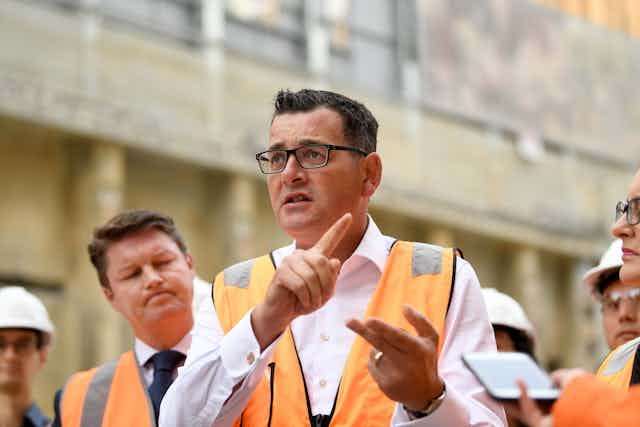The Victorian election will be held on November 24, and the New South Wales election in March next year. Newspolls have been conducted in these states in February and early March from samples of 1,268 in Victoria and 1,526 in New South Wales. Labor led by 52-48 in Victoria, and was tied 50-50 in New South Wales, a one-point gain for Labor since February to March 2017.
In Victoria, primary votes were 39% Coalition, 37% Labor, 11% Greens and 6% One Nation. The last Victorian Newspoll was conducted in 2016, so it is not useful for comparison. However, Galaxy polling had Labor slumping to a 53-47 deficit in June 2017, before recovering to a 50-50 tie in December, so this Newspoll suggests a continuing trend to Labor.
Read more: Labor wins a majority in Queensland as polling in Victoria shows a tie
Premier Daniel Andrews’ ratings were 46% satisfied, 41% dissatisfied. Opposition Leader Matthew Guy’s ratings were 36% satisfied, 37% dissatisfied. Andrews led Guy 41-30 as better premier.
Labor led the Liberals 44-34 on party best to maintain energy supply and keep power prices lower, while the Liberals led 42-37 on law and order. 65% thought the Andrews government should be doing more to reduce gang violence, while just 25% thought it was doing enough.
This poll will be a major disappointment for right-wing media that have campaigned strongly against Labor on the gang violence issue. Despite this campaign, the Liberals only have a five-point lead over Labor on law and order, a conservative-leaning issue. Other issues are likely to be helping Labor.
In New South Wales, primary votes were 38% Coalition (down two), 34% Labor (steady), 11% Greens (up one) and 8% One Nation (steady). This Newspoll is the first since early 2008 that has not had a Coalition lead after preferences.
Premier Gladys Berejiklian’s ratings were 45% satisfied (up one since February to March 2017), 35% dissatisfied (up 14). Opposition Leader Luke Foley’s ratings were 37% satisfied (up five), 35% dissatisfied (down one). Berejiklian led Foley 43-25 as better premier (43-21 previously).
New South Wales is the only state that now uses optional preferential voting for single-member electorates. All other state and national elections use compulsory preferential voting (Queensland changed to compulsory preferential during the last parliamentary term).
Populists dominate Italian election
At the Italian election on March 4, the centre-right coalition won 37.0% of the vote, the populist left Five Star Movement won 32.7% and the centre-left coalition 22.9%. Within the right coalition, the anti-immigrant populist League won 17.4%, while former PM Silvio Berlusconi’s Forza Italia had just 14.0%.
37% of both chambers of the Italian Parliament were elected by “first past the post”, while the remainder used proportional representation. The right coalition’s narrow lead over the Five Star Movement did not allow them to win a large majority of the first past the post seats, and they were well short of an overall majority.
42-43% of both chambers went to the right coalition, 36% to the Five Star Movement and 18-19% to the left coalition. A governing coalition could be formed between Five Star and the Democratic Party, the main component of the left coalition. It is also possible that the League and Five Star could combine, or a new election may be needed.
Read more: Will elections in 2018 see 2017's left-wing revival continue?
More than five months after election, German government formed
On March 4, the Social Democrats’ members voted by 66-34 to join Angela Merkel’s Christian Democrats in a grand coalition - the same right/left coalition that had governed Germany from 2013-17.
At the September 2017 election, the Social Democrats’ vote had fallen to 20.5% - its lowest in a free election since 1932. Since the election, their vote has fallen to about 17%. It is difficult for a centre-left party in coalition with conservatives to differentiate itself.
Read more: NZ First to hold balance of power after election; far-right AfD wins 12.6% in Germany
By the next German election, due in 2021, it would be no surprise if the Social Democrats had fallen into single figures, and been overtaken by one or both of the more left-wing parties - the Greens and the Left.
Centre-left parties faltering in Europe, but UK Labour is performing much better
The German and Italian elections are examples of a Europe-wide problem for centre-left parties. The exception appears to be the UK, where Jeremy Corbyn’s Labour won 40% at the June 2017 election, and is now neck-and-neck with the Conservatives, with both parties in the 40’s.
I believe the most important cause of this disparity is that UK Labour has adopted many populist left policies, while European centre-left parties resist populist policies.
Putin set for crushing victory at March 18 Russian election
Incumbent Russian President Vladimir Putin is polling over 60%, and will win the first round of the Russian Presidential election on March 18 with an outright majority, avoiding a runoff. The other candidates all have under 10% support.

